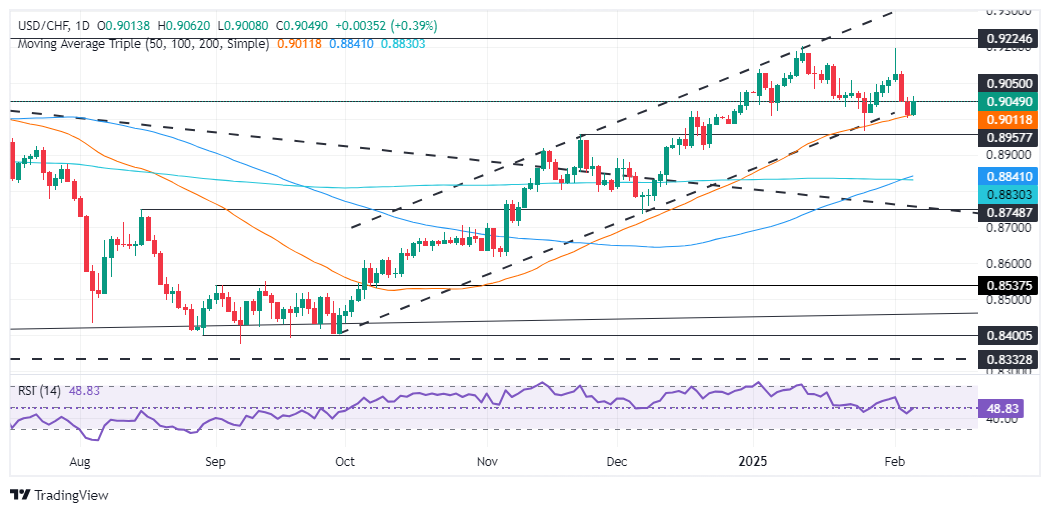USD/CHF Price Analysis: Reclaims 0.9000 ahead of US NFP data
- USD/CHF rebounds to 0.9048, gaining momentum after forming a "tweezers bottom" pattern at critical support levels.
- Upcoming Nonfarm Payroll figures heighten market focus, following unexpected rise in unemployment claims.
- Technical outlook suggests potential range trading, with a critical resistance at 0.9100 and support near 0.8998.
The USD/CHF reversed course and trimmed some of its weekly losses, posting gains of over 0.36%. At the time of writing, it was exchanged at 0.9048.
US jobs data showed that more people than expected applied for unemployment benefits, which could be linked to the Los Angeles wildfires and the weather. In the meantime, traders braced for the release of US Nonfarm Payroll figures on Friday.
USD/CHF Price Analysis: Technical outlook
The USD/CHF reversed its course, forming a “tweezers bottom” chart pattern. The pair found strong support at 0.8998 at the 50-day Simple Moving Average (SMA). If buyers achieve a daily close above 0.9000, look for some range-bound trading within the 0.9040 – 0.9100 area. A breach of the top of the range will expose the February 3 high at 0.9195.
Conversely, if the USD/CHF price closes below the 50-day SMA daily, further downside is seen, as the next support would be the November 22 daily high at 0.8957, followed by 0.8900.
USD/CHF Price Chart – Daily

Swiss Franc FAQs
The Swiss Franc (CHF) is Switzerland’s official currency. It is among the top ten most traded currencies globally, reaching volumes that well exceed the size of the Swiss economy. Its value is determined by the broad market sentiment, the country’s economic health or action taken by the Swiss National Bank (SNB), among other factors. Between 2011 and 2015, the Swiss Franc was pegged to the Euro (EUR). The peg was abruptly removed, resulting in a more than 20% increase in the Franc’s value, causing a turmoil in markets. Even though the peg isn’t in force anymore, CHF fortunes tend to be highly correlated with the Euro ones due to the high dependency of the Swiss economy on the neighboring Eurozone.
The Swiss Franc (CHF) is considered a safe-haven asset, or a currency that investors tend to buy in times of market stress. This is due to the perceived status of Switzerland in the world: a stable economy, a strong export sector, big central bank reserves or a longstanding political stance towards neutrality in global conflicts make the country’s currency a good choice for investors fleeing from risks. Turbulent times are likely to strengthen CHF value against other currencies that are seen as more risky to invest in.
The Swiss National Bank (SNB) meets four times a year – once every quarter, less than other major central banks – to decide on monetary policy. The bank aims for an annual inflation rate of less than 2%. When inflation is above target or forecasted to be above target in the foreseeable future, the bank will attempt to tame price growth by raising its policy rate. Higher interest rates are generally positive for the Swiss Franc (CHF) as they lead to higher yields, making the country a more attractive place for investors. On the contrary, lower interest rates tend to weaken CHF.
Macroeconomic data releases in Switzerland are key to assessing the state of the economy and can impact the Swiss Franc’s (CHF) valuation. The Swiss economy is broadly stable, but any sudden change in economic growth, inflation, current account or the central bank’s currency reserves have the potential to trigger moves in CHF. Generally, high economic growth, low unemployment and high confidence are good for CHF. Conversely, if economic data points to weakening momentum, CHF is likely to depreciate.
As a small and open economy, Switzerland is heavily dependent on the health of the neighboring Eurozone economies. The broader European Union is Switzerland’s main economic partner and a key political ally, so macroeconomic and monetary policy stability in the Eurozone is essential for Switzerland and, thus, for the Swiss Franc (CHF). With such dependency, some models suggest that the correlation between the fortunes of the Euro (EUR) and the CHF is more than 90%, or close to perfect.

